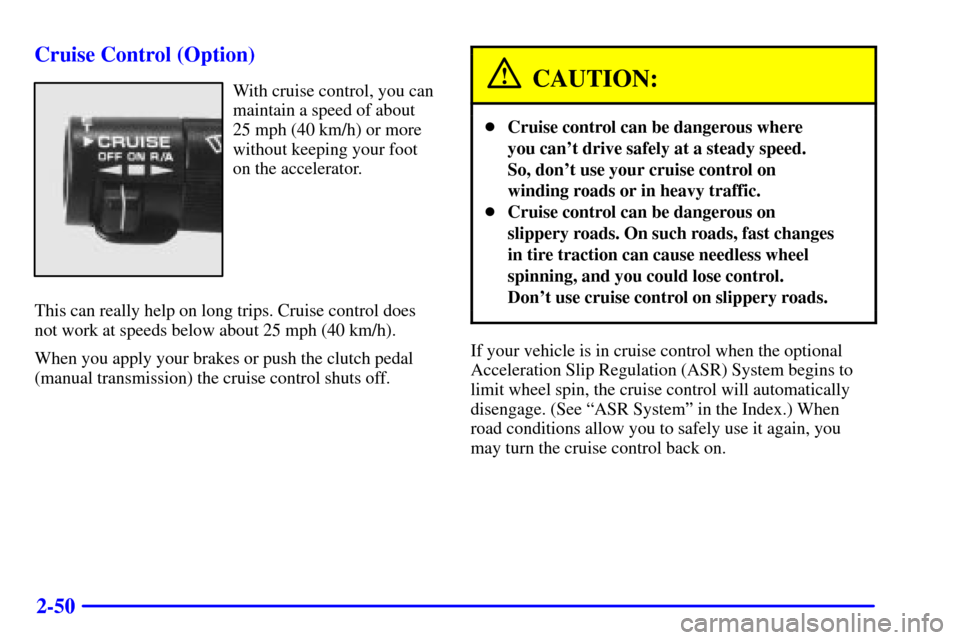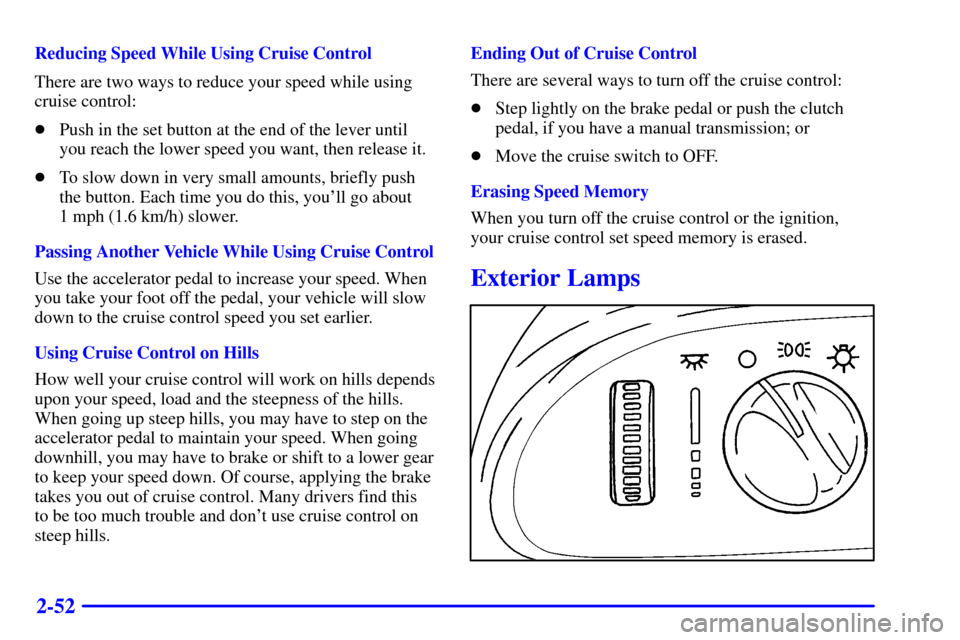Page 4 of 357
Table of Contents
Keys and Door Locks
Remote Keyless Entry (RKE) System
Hatch
Automatic Transmission (If Equipped)
Manual Transmission Operation (If Equipped)
Parking Brake
Windows
Tilt Wheel
Turn Signal/Multifunction LeverWindshield Wipers
Cruise Control
Interior and Exterior Lamps
Mirrors
Storage Compartments
Cargo Cover
Accessory Power Outlet
Instrument Panel, Warning Lights and Gages Seats and Seat Controls
Safety BeltsAir Bag System
Child Restraints
Section
1
Section
2
Seats and Restraint Systems
Features and Controls
ii
Page 104 of 357
2-47
Tilt Wheel
A tilt wheel allows you to adjust the steering wheel
before you drive. It is located on the left side of the
steering column.
You can also raise it to the highest level to give your
legs more room when you exit and enter the vehicle.
To tilt the wheel, hold the steering wheel and pull the
lever. Move the steering wheel to a comfortable level,
then release the lever to lock the wheel in place.
Turn Signal/Multifunction Lever
The lever located on the left side of the steering column
includes your:
�Turn Signal and Lane Change Indicator
�Headlamp High/Low
-Beam Changer and
Passing Signal
�Windshield Wipers
�Windshield Washer
�Cruise Control (Option)
Page 107 of 357

2-50 Cruise Control (Option)
With cruise control, you can
maintain a speed of about
25 mph (40 km/h) or more
without keeping your foot
on the accelerator.
This can really help on long trips. Cruise control does
not work at speeds below about 25 mph (40 km/h).
When you apply your brakes or push the clutch pedal
(manual transmission) the cruise control shuts off.CAUTION:
�Cruise control can be dangerous where
you can't drive safely at a steady speed.
So, don't use your cruise control on
winding roads or in heavy traffic.
�Cruise control can be dangerous on
slippery roads. On such roads, fast changes
in tire traction can cause needless wheel
spinning, and you could lose control.
Don't use cruise control on slippery roads.
If your vehicle is in cruise control when the optional
Acceleration Slip Regulation (ASR) System begins to
limit wheel spin, the cruise control will automatically
disengage. (See ªASR Systemº in the Index.) When
road conditions allow you to safely use it again, you
may turn the cruise control back on.
Page 108 of 357

2-51
Setting Cruise Control
CAUTION:
If you leave your cruise control switch on when
you're not using cruise, you might hit a button
and go into cruise when you don't want to. You
could be startled and even lose control. Keep the
cruise control switch off until you want to use
cruise control.
1. Move the cruise control switch to ON.
2. Get up to the speed you want.
3. Push in the SET button at the end of the lever and
release it.
4. Take your foot off the accelerator pedal.Resuming a Set Speed
Suppose you set your cruise control at a desired speed
and then apply the brake or clutch pedal. This, of course,
shuts off the cruise control. But you don't need to reset it.
Once you're going about 25 mph (40 km/h) or more,
you can move the cruise control switch from ON to R/A
(Resume/Accelerate) briefly.
You'll go right back up to your chosen speed and
stay there.
Increasing Speed While Using Cruise Control
There are three ways to go to a higher speed:
�Use the accelerator pedal to get to the higher speed.
Push the set button at the end of the lever, then
release the button and the accelerator pedal. You'll
now cruise at the higher speed.
�To increase your speed in very small amounts,
briefly move the switch to R/A and then release it.
Each time you do this, your vehicle will go about
1 mph (1.6 km/h) faster.
�Move the cruise switch from ON to R/A. Hold it
there until you get up to the speed you want, and
then release the switch.
Page 109 of 357

2-52
Reducing Speed While Using Cruise Control
There are two ways to reduce your speed while using
cruise control:
�Push in the set button at the end of the lever until
you reach the lower speed you want, then release it.
�To slow down in very small amounts, briefly push
the button. Each time you do this, you'll go about
1 mph (1.6 km/h) slower.
Passing Another Vehicle While Using Cruise Control
Use the accelerator pedal to increase your speed. When
you take your foot off the pedal, your vehicle will slow
down to the cruise control speed you set earlier.
Using Cruise Control on Hills
How well your cruise control will work on hills depends
upon your speed, load and the steepness of the hills.
When going up steep hills, you may have to step on the
accelerator pedal to maintain your speed. When going
downhill, you may have to brake or shift to a lower gear
to keep your speed down. Of course, applying the brake
takes you out of cruise control. Many drivers find this
to be too much trouble and don't use cruise control on
steep hills.Ending Out of Cruise Control
There are several ways to turn off the cruise control:
�Step lightly on the brake pedal or push the clutch
pedal, if you have a manual transmission; or
�Move the cruise switch to OFF.
Erasing Speed Memory
When you turn off the cruise control or the ignition,
your cruise control set speed memory is erased.
Exterior Lamps
Page 187 of 357

4-10
If your vehicle is in cruise control when the ASR
system begins to limit wheel spin, the cruise control will
automatically disengage. When road conditions allow
you to safely use it again, you may re
-engage the
cruise control. (See ªCruise Controlº in the Index.)
When the system is on,
this warning light will
come on to let you know
if there's a problem with
your ASR system. See
ªASR System Warning
Lightº in the Index.
When this warning light is on, the system will not limit
wheel spin. Adjust your driving accordingly.
The ASR system automatically comes on whenever
you start your vehicle. To limit wheel spin, especially
in slippery road conditions, you should always leave the
system on. But you can turn the ASR system off if you
ever need to. (You should turn the system off if your
vehicle ever gets stuck in sand, mud, ice or snow.
See ªRocking Your Vehicleº in the Index.)
To turn the system off,
press the ASR button
located on the
instrument panel.
The ASR system warning light will come on and stay
on. If the ASR system is limiting wheel spin when you
press the button, the warning light will come on
-- but
the system won't turn off right away. It will wait until
there's no longer a current need to limit wheel spin.
You can turn the system back on at any time by
pressing the button again. The ASR system warning
light should go off.
Page 316 of 357
6-65
Fuse Usage
ENG SEN Mass Air Flow, Heated Oxygen
Sensor, Skip Shift Solenoid
(V8 Only), Reverse Lockout
Solenoid, Brake Switch
STRTR Powertrain Control Module (PCM)
and Clutch Pedal Switch
ABS IGN Anti
-Lock Brake System Module
PCM IGN Powertrain Control Module (PCM)
ETC Electronic Throttle Control
(V6 Only)
ENG CTRL Ignition Module (V6 Only),
Automatic Transmission and
Charcoal Canister Purge Solenoid
A/C CRUISE Air Conditioning Compressor
Relay, Cruise Control Switches
and ModuleFuse Usage
ENG CTRL Engine Controls, Fuel Pump,
Powertrain Control Module (PCM),
A.I.R. and Cooling Fans
I/P
-1 HVAC Blower Control and Relay
IGN Ignition Switch, Relay and Starter
Enable Relay
I/P
-2 Instrument Panel Fuse Center
Relay Description
Blank Not Used
AIR PUMP Air Pump
A/C COMP Air Conditioning Compressor
FUEL PUMP Fuel Pump
STARTER Starter
IGN Engine Controls, Cruise Control,
Air Conditioning
Page 340 of 357
7-22 Throttle System Inspection
(Except 3800 Series V6 Engine)
Inspect the throttle system for interference or binding,
and for damaged or missing parts. Replace parts as
needed. Replace any components that have high effort
or excessive wear. Do not lubricate accelerator and
cruise control cables.
Rear Axle Service
Check the gear lubricant level in the rear axle and add
if needed. See ªRear Axleº in the Index. A fluid loss
may indicate a problem. Check the axle and repair it
if needed.
Brake System Inspection
Inspect the complete system. Inspect brake lines
and hoses for proper hook
-up, binding, leaks, cracks,
chafing, etc. Inspect disc brake pads for wear and
rotors for surface condition. Inspect other brake parts,
including calipers, parking brake, etc. Check parking
brake adjustment. You may need to have your brakes
inspected more often if your driving habits or conditions
result in frequent braking.